DigitalStorm BlackOps: Almost Too Fast
by Dustin Sklavos on December 29, 2010 12:45 AM ESTApplication and Futuremark Performance
It's not unreasonable to expect that given the blisteringly fast overclock on the Intel Core i7-950, the DigitalStorm BlackOps we have on hand should dominate our benchmarks. This is only made more apparent by the Corsair Force SSD (which PCMark Vantage is going to love) and the SLI'd GeForce GTX 580s. So just how much of a lead can the BlackOps pull?
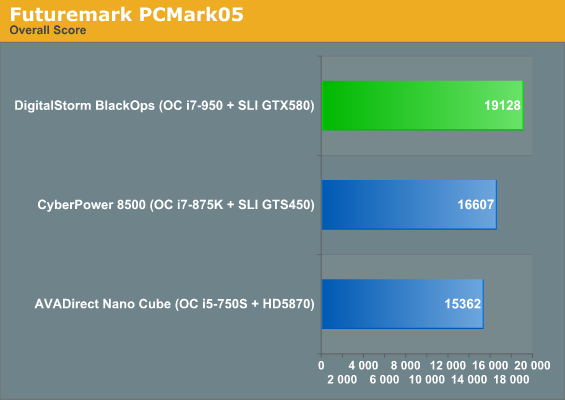

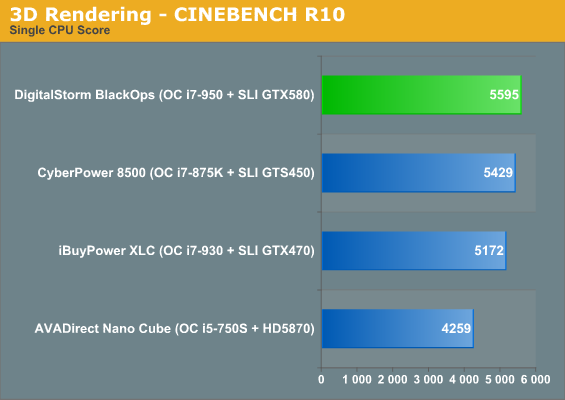
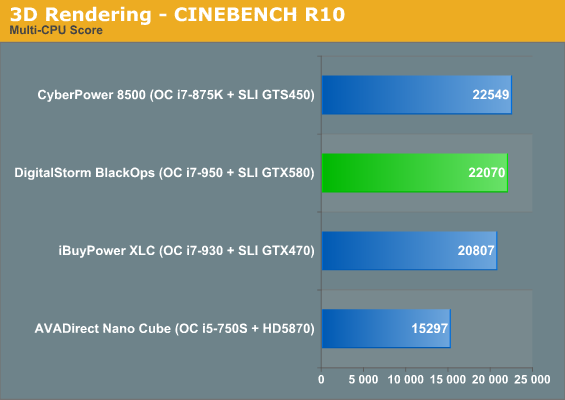
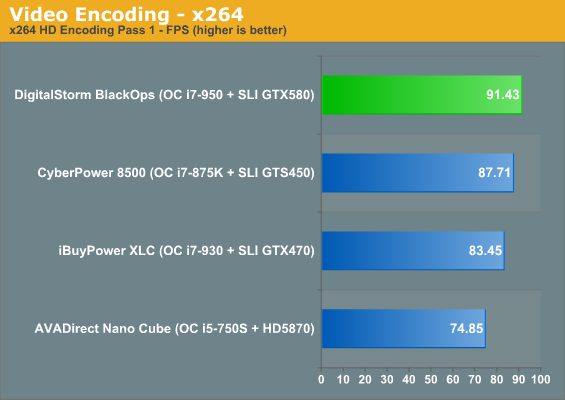
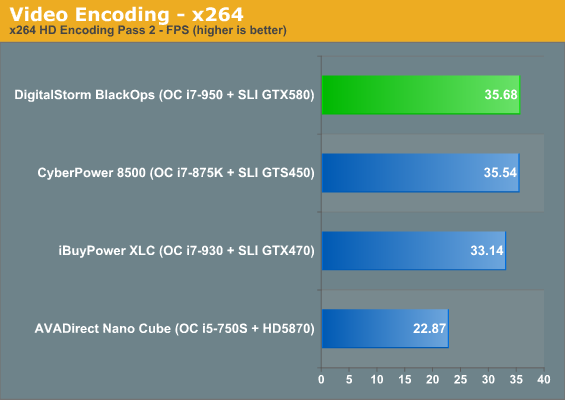
And there it is. The BlackOps posts its only loss in Cinebench's multi-CPU test, but the score is so close to the i7-875K powering the CyberPower desktop that it's barely worth mentioning. To be fair, though, the CyberPower unit costs a little over half what the BlackOps does. Of course, when we move into 3DMark we can expect to see where that price difference really comes in.
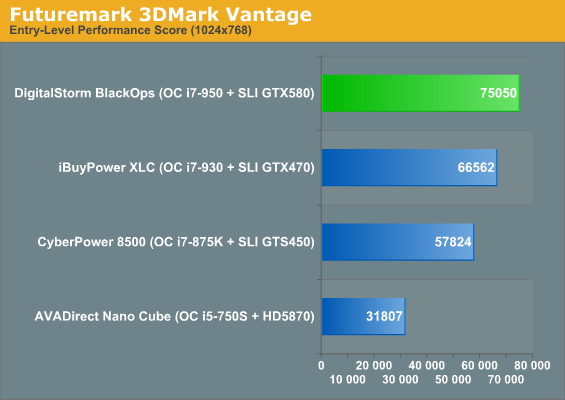
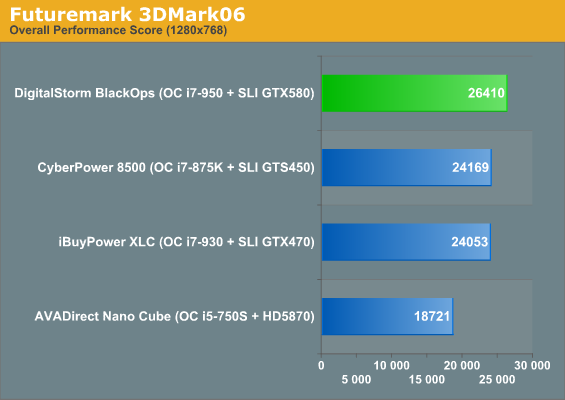


While 3DMarks 06 and 05 seem to be almost CPU-limited, the BlackOps tears away from the pack in 03 and Vantage thanks to the massive performance of the SLI'd GeForce GTX 580s. The closest competition comes from the iBuyPower unit with the SLI GTX 470s, but it's nowhere near what the BlackOps is capable of. When we get into our gaming benchmarks on the next page, that's only going to be more apparent.










76 Comments
View All Comments
Voldenuit - Wednesday, December 29, 2010 - link
Nice read, it's interesting to see what the boutique builds can do.My question is: what happens when you (manually) tame the voltages and power saving technologies in the system? Can it be brought down to idle more sensibly?
No question that this should not be expected of the end-user (especially any end user who would buy such a high end rig instead of building their own), but I am curious how efficient a build such as the Blackops can be made to run.
vol7ron - Wednesday, December 29, 2010 - link
"especially any end user who would buy such a high end rig instead of building their own"When you are immersed with lots of work and little time, live in small dwellings like an apartment/studio, don't have spare parts to test damaged/DOA units, or just don't want to deal with one of the many complications/time that can come from a new build; then you might be one of those end-users that sees this as a viable alternative to building your own.
Afterall, sites like iBuyPower are great in the fact that you're given the power that an HP/Dell/Apple just can't give you and while there is a little premium, it's only slightly larger than building it yourself - definitely not the markup of the said named brands.
------------------------------------------
Your question of efficiency is unclear. The computer is plenty efficient when it's "sleep"ing :) Of course you can scale the power down, but why would you want to? You're paying all this money not to. You could also remove it from SLI, but again, why would you want to?
I can see what you're getting at, but this isn't for a notebook, this is a gaming rig =D
marc1000 - Wednesday, December 29, 2010 - link
I second your question."what happens when you (manually) tame the voltages and power saving technologies in the system? Can it be brought down to idle more sensibly?"
L. - Wednesday, March 16, 2011 - link
Yes.This computer is a joke.
Anyone who knows how to overclock will tell you this is overpriced, failed overclocking, cheap RAM and ... come on. Watercooling for this ?? this can be cooled on air any day (and maybe even with the stock cooler, around 80°C (lol) .
The guy above says people who have the money but not the time could be interested, I agree but this one is a relatively bad combo.
bijeshn - Wednesday, December 29, 2010 - link
Aren't there any desktops in the market sporting a crossfire configuration? All your benchmarks are comparing SLI configs with a single 5870 (AVA Direct Nano Cube). Are they really comparable?GeorgeH - Wednesday, December 29, 2010 - link
The A-Data RAM ran flawlessly in the machine, but you'd rather see a different brand? Does <Brand X> RAM do something besides run flawlessly?You want a different 1200W PSU, but don't mention what's actually in the machine or why you want a Corsair supply? Why? Is the Corsair more efficient, or quieter?
Your machine runs circles around this because it lacks E-Sata? Really? E-Sata is a $5 bracket, and the machine comes with USB 3.0. Digital audio is a flaw, but how many PC speakers accept digital inputs?
You mention a price premium, but don't bother to spec out what that is? For the record the parts and OS will run you ~$2800, so it's about an $800 assembly and lazy overclock fee.
Bottom line this seemed like a really lazy review.
Kaboose - Wednesday, December 29, 2010 - link
agreed, seemed rushed, not well thought out and sloppy. -1bah12 - Wednesday, December 29, 2010 - link
The biggest flaw (and this is not Dustin's). Was the 1080p resolution game tests. IMO absolutely unacceptable, the type of person buying this rig would certainly "must have" a 30".This and yesterday's HTPC case review are 2 articles in a row where he is limited by testing equipment. I get it, he's new. But come on for pete's sake this is Anandtech one of if not the biggest tech site on web, get him a proper test bench or relegate him to news/editorials. Content for the sake of content is DT not AT.
1080p gaming on a $3,500+ machine...shameful.
ClownPuncher - Wednesday, December 29, 2010 - link
30" or a surround setup with 3 monitors. There wasn't any reason to bench this thing at 1920x1080.landerf - Wednesday, December 29, 2010 - link
Not at all. 2560 displays are slow, expensive and downright a pointless pain to use. Everything is microscopic on them, and it's uncommon to spend 1/3 of your pc's price on the monitor. 1/8-1/10 is much more common. Having an absurdly highend rig I would like more than 1080p, but no more than 1400p